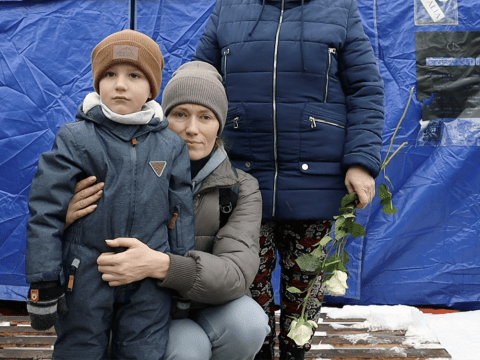Protecting children from war: physically and emotionally

“Let them think this is just a trip,” Julia a mother from Ukraine says as she looks at her daughters; 7-year-old twins Elisabeth and Caterina, and 17-year-old Alina.
“The kids are asking ‘Why are we leaving? Where are we going? Why are we hiding?’”
We try not to panic so they will not know what war is. We are telling them that they will….” she falters, crying, and trying to find the right words to explain how she is trying to protect her daughters from the brutal truth of what they have just escaped.
Protecting their emotions: “We try not to tell them this is war.”
Julia is at the Romanian border in a tent sheltering from the snow after she and her children escaped from Ukraine. The twins are wearing matching light blue coats and pink caps. Other than the clothes on their backs, the family has nothing with them.
“My children are just in these clothes. We don’t even have anything to change into. We have our documents, but we don’t have any money. We can’t pay for transport anywhere.”
When the conflict hit their home in the Ukrainian capital of Kyiv, she was caught off guard. “We didn’t think that this would happen. And then we woke up to explosions. There were bombs and shooting. Destroyers were flying right above our house. I couldn’t believe what was happening.”
She never thought they’d have to leave their home, let along the country she was born and raised in. She never thought she’d have to leave her own mother behind.
Surviving today, worried about tomorrow
While Julia’s priority now is to try to make their way to Germany, where she hopes friends will be able to help them, she already worries about her daughters’ futures.
“We don’t know when we will be able to come back home. How will they do their exams? Where will they go to school?”
“We just want to go back home,” she says, with pain etched on her face. “We want peace. We want to live in our Ukraine. In our house. That’s all…”
Displacement, all-too-common experience
Unfortunately, Julia’s story is not uncommon. Globally, more than 82 million people have been forcibly displaced. Parents everywhere have the same desires for their children: A safe place to live, food to eat and opportunities.
Another mother who recently arrived in Romania from Ukraine, also called Julia, has fled with her mother and her 3-year-old son, Nicom.
"Nicom is tired and doesn't understand what is happening,” she says quietly as her mother watches him.
“He thinks he's going on a vacation.”
More questions than answers
Despite the generosity and kindness being shown by neighbouring countries, Julia is on her own, and the reality she is now facing couldn’t be further from the holiday Nicom thinks he is on.
Like others arriving in a new country, she doesn’t speak the language, it’s hard to navigate public transport and they don’t have clothes, food or money - they’ve left everything they have. Where does she go now? How long will she be here for? How will she get food? How will she care for Nicom and her mother? Will she see her family and friends again? When can she just go home?
Ukraine, the most recent refugee crisis
We’ve all seen how the conflict in Ukraine has forced so many children to leave everything behind.
But the problem is so much bigger than just Ukraine. Across the world, there are more than 20 million refugees. Many have not been home in many years.
For more than 70 years, we have been supporting the needs of refugees. World Vision teams are working to support refugees from Ukraine, South Sudan, Myanmar and Syria as well as other locations around the globe.
Help our teams to protect and provide for children whose lives have been changed in an instant.